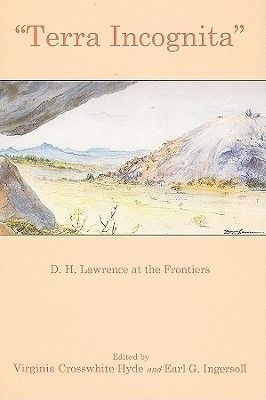
"Terra Incognita" D.H. Lawrence at the Frontiers
"Terra Incognita": D. H. Lawrence at the Frontiers, edited by Virginia Crosswhite Hyde and Eari G. Ingersoll, is a collection of nine essays by scholars from five countries. They show ways in which Lawrence explored not only remote regions of the earth but also consciousness and human relations. The book also considers implications of terms like "frontier," "boundary," and "place." It gives readings that are the first to utilize new texts and research in the final prose volumes of the Cambridge Lawrence Edition. This includes all the essays Lawrence wrote in America about Southwestern and Mexican Indians (Mornings in Mexico and Other Essays, 2009). Writers are Michael Hollington, Judith Ruderman, Edina Pereira Crunfli, Tina Ferris, Virginia Crosswhite Hyde, Jack Stewart, Keith Cushman, Julianne New-mark, and Paul Poplawski. In addition to the essays, the book contains eight pages of color illustrations. It will interest both general readers and scholars of Lawrence and of twentieth-century literature. Lawrence wrote of "terra incognita," referring above all to genuine "face-to-face" contacts with our surroundings and with other people, beyond confining walls of the status quo with its counterfeit encounters. These contacts are his ultimate frontiers where, in particular, he sought new understanding of class, race, and relationship. The 1920s emerge in these essays as a great watershed in his life and work, when he traveled the earth and settled for a time in America, addressed issues of colonialism and multiculturalism, wrote alongside activist John Collier for Pueblo property rights, and not only published some of his finest fiction and poetry but also helped to launch scholarly interest in his works. Visual art is by Lawrence, Georgia O'Keeffe, and Dorothy Brett. A little-known Lawrence landscape illustrates "terra incognita" in a particularly graphic way. Although Lawrence and O'Keeffe did not know each other in New Mexico, their love of austere Southwestern landscape proves comparable in her graphic medium and his literary work. Dorothy Brett, an English-born painter who lived with the Lawrences in America, depicted Pueblo ceremonials in paintings that can be compared and contrasted with Lawrence's literary descriptions of similar dances. Contributions range from territorial outposts in Roman Europe, to Polar expeditions of the last "Heroic Age" of exploration, to Lawrence's own residence in the American Southwest and Mexico. Writers employ ideas by a wide range of theorists, including Mikhail Bakhtin, Edward Said, and Yi-Fu Tuan, as well as a galaxy of Lawrence critics.